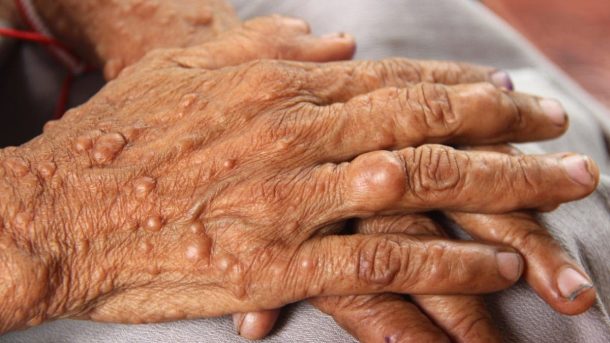Neurofibromatosis Type 1 (NF1), also known as von Recklinghausen disease, is a genetic disorder that primarily affects the skin and nervous system. Characterized by the growth of non-cancerous tumors along nerves, it can also lead to changes in skin pigmentation and bone deformities. While often mild, the condition may sometimes cause serious health issues, making early diagnosis and regular monitoring essential.
Symptoms
NF causes tissue along the nerves to grow uncontrollably. This growth can put pressure on affected nerves.
If the growths are in the skin, there can be cosmetic issues. If the growths are in other nerves or parts of the body, they can cause pain, severe nerve damage, and loss of function in the area the nerve affects. Problems with feeling or movement can occur, depending on which nerves are affected.
The condition can be very different from person to person, even among people in the same family who have the same NF1 gene change.
“Coffee-with-milk” (café au lait) spots are the hallmark symptom of NF. Many healthy people have one or two small café au lait spots. However, adults who have six or more spots that are bigger than 1.5 cm in diameter (0.5 cm in children) could have NF. In some people with the condition, these spots may be the only symptom.
Other symptoms may include:
- Tumors of the eye, such as optic glioma
- Seizures
- Freckles in the underarm or groin
- Large, soft tumors called plexiform neurofibromas, which may have a dark color and may spread under the
- surface of the skin
- Pain (from affected nerves)
- Small, rubbery tumors of the skin called nodular neurofibromas
Causes of NF1
- Genetic Mutation: NF1 is caused by mutations in the NF1 gene on chromosome 17.
- Inheritance Pattern: It follows an autosomal dominant pattern, meaning if one parent has NF1, there is a 50% chance of passing it to their child.
- Spontaneous Mutations: Around 50% of NF1 cases occur without any family history due to new mutations.
Diagnosis
- NF1 is usually diagnosed based on clinical criteria, including:
- The presence of multiple café-au-lait spots
- Two or more neurofibromas or one plexiform neurofibroma
- Lisch nodules
- Bone deformities
- A first-degree relative with NF1
In some cases, genetic testing can confirm the diagnosis.
Treatment
There is no specific treatment for NF. Tumors that cause pain or loss of function may be removed. Tumors that have grown quickly should be removed promptly as they may become cancerous (malignant). The drug selumetinib (Koselugo) was approved by the US Food and Drug Administration in 2020 for use in children with severe tumors.
Some children with learning disorders may need special schooling.
When to See a Doctor
- You should consult a doctor if:
- You or your child develops multiple café-au-lait spots or skin bumps
- Tumors are growing rapidly or causing pain
- There are signs of vision problems, scoliosis, or bone deformities
- Behavioral or learning issues arise in children
- There’s a family history of NF1 and you’re planning to have children
Conclusion
Neurofibromatosis Type 1 is a complex but manageable condition. Although it can present physical and emotional challenges, advancements in treatment and supportive care offer hope for those affected. If you suspect NF1 in yourself or a loved one, don’t hesitate to reach out to a healthcare provider for evaluation and guidance.



